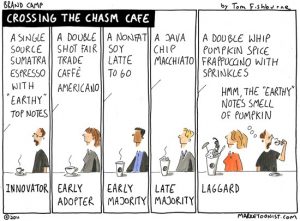Diffusion of Innovation Theory
 Innovation stimulates growth of a business. The ability to keep on generating winning ideas for new products and services is one of the keys to business success. Entrepreneurs value innovations; they have a natural instinct regarding innovations, because they know that innovations in products, service, or a business process make their business unique, allowing the business to acquire core competence.
Innovation stimulates growth of a business. The ability to keep on generating winning ideas for new products and services is one of the keys to business success. Entrepreneurs value innovations; they have a natural instinct regarding innovations, because they know that innovations in products, service, or a business process make their business unique, allowing the business to acquire core competence.
Innovations in business need to be diffused in society. When new products are introduced in markets they do not get adopted by consumers very easily. People are generally averse to adopting new ideas, new products, new theories, and new concepts because for fear of failure. Lot of research has been conducted in social science on the topic of adoption of newness and it is found that people who adopt an innovation easily and relatively early have different characteristics than people who adopt an innovation later. Therefore, marketers study the target markets before launching their products. It is important to understand the characteristics of the target population because they might help or hold back adoption of the new product.
‘Diffusion’ as a concept was first introduced by a French sociologist Gabriel Tarde in late 19th century. Later it was elucidated by German and Austrian anthropologists Friedrich Ratzel and Leo Leo Frobenius.
In early 1920s and 1930s agricultural technology was advancing at a faster pace. Farmers had started adopting hybrid seeds, fertilizers, agricultural equipments and technologies for augmenting their produce. In 1943, in Lowa, Ryan and Gross, both social scientists made concrete observation and finding on the topic of diffusion of innovation; they researched the pattern of adoption of hybrid corn seeds by farmers. Thus first time diffusion of innovation was studied in rural context. It first made its mark in rural sociology. Diffusion of Innovation has been applied to numerous contexts since then; marketing, city development, medical sociology, health science, health promotion, research, knowledge management, and many complex areas. Diffusion of Innovation has particularly been used to large extent in the field of medical sciences, medical technique and health communication.
In 1962, Everett Rogers, a professor of Communication Studies, published his seminal work: Diffusion of Innovations. Rogers produced his research from over 508 diffusion studies across the fields that initially influenced the theory. Among the topic were anthropology, sociology, rural sociology, education, and medical sociology. Everett Rogers produced a theory of the adoption of innovations among individuals and organizations. Later, he published in his first edition of book in the same year.
 Rogers recommended that four main elements influence the spread of a new idea: the innovation itself, communication channels, occasion (time), and a social system. This process relies heavily on psychologies of people. The innovation must be widely adopted in order to get accepted and self-sustain. Within the rate of adoption, there is a point at which an innovation reaches critical mass. The expansion of the car industry is well described and is a classical example to describe the diffusion of innovation theory. The modern communication is infusing more and more innovation in the cars. The car industry is approaching a dramatic shift entering into a new phase of communication driven by modern communication technology and environmental concerns. The new car models will sooner or later have smart phones on wheels.
Rogers recommended that four main elements influence the spread of a new idea: the innovation itself, communication channels, occasion (time), and a social system. This process relies heavily on psychologies of people. The innovation must be widely adopted in order to get accepted and self-sustain. Within the rate of adoption, there is a point at which an innovation reaches critical mass. The expansion of the car industry is well described and is a classical example to describe the diffusion of innovation theory. The modern communication is infusing more and more innovation in the cars. The car industry is approaching a dramatic shift entering into a new phase of communication driven by modern communication technology and environmental concerns. The new car models will sooner or later have smart phones on wheels.
The categories of adopters are: innovators, early adaptors, early majority, late majority, and laggards. Diffusion manifests itself in different ways in various cultures and fields and is highly subject to the type of adopters and innovation-decision process.
 Innovators: These are enthusiastic customers who want to be the first ones to try the innovation. They are adventurous and interested in trying out new ideas, services and products. These people are risk takers, and do not shy from trying out and sometimes getting bad results in trying new products. They are the ones to be tapped to reach out and market new products.
Innovators: These are enthusiastic customers who want to be the first ones to try the innovation. They are adventurous and interested in trying out new ideas, services and products. These people are risk takers, and do not shy from trying out and sometimes getting bad results in trying new products. They are the ones to be tapped to reach out and market new products.
Early Adopters: These are opinion leaders in the markets. They enjoy leadership roles and are relatively flexible to adopt changed opportunities. They are already aware of the need to change; they are always on lookout for more progressive changes in the society. Strategies to appeal to this population include detailed ‘how-to’ manuals and information sheets on implementation. They don’t need to be perused too much to buy new products. They are more than eager themselves for change. Early adopters are typically described as curious, exploratory consumers who buy first, talk fast and spread the word to others about the pros and cons of what they have purchased.
Early Majority: These people are rarely leaders, but they do adopt new ideas before the average person. They are observant and patient by nature. They like to satisfy themselves by seeing others comfortably using the new product, idea or theory. They look out for evidence that the innovation works before they buy and adopt it. Strategies to appeal to this population include success stories and verification of the innovation’s effectiveness. They rely a lot on evidences.
Late Majority: These people are skeptical of change; they will adopt an innovation only after it has been tried by the majority. They like to go by statistical proof on how many people have tried and are happy with new product. Strategies to appeal to this population include information on how many other people have tried the innovation and have adopted it successfully. They need statistical sheets for studying.
Laggards: These people are bound by tradition and are very conservative. They are very skeptical of change and are the hardest group to please. They are averse to change. Strategies to appeal to this population include statistics, fear appeals, and pressure from people in the other adopter groups.
This example might be apt in expressing how diffusion of innovation worked in case of smart phone in America. The 2.5% Innovators were tapped in February 2007; one month after the iPhone was announced. They were all BlackBerry users. The Early Adopters (the 13.5% which followed the innovators) were all using smart phones by the beginning of 2010. They were served mainly by iPhone 3GS and Blackberries. The Early Majority (34%) were on board by October 2012, just in time for iPhone 4, Android, Galaxy. We see now the Late majority (34%) which will run out by November 2015 and Laggards (16%) would get anyways dragged to buy smart phones only when they go in to replace their old phones. The iPhone 5S came out about one third of the way through this period. So, Americans need more innovative smart phones as more than 50% market is already penetrated.
People are not born as particular a particular category of adaptors:
If a person in early adopter in case of buying a car or a smart phone, he might be late majority or laggard while considering a Post Graduation degree program. A person who might be innovator in watching any new movie might be laggard when it comes to investing in mutual fund. So it is not a hard and fast rule that people are born as innovators, early adaptors, early majority, late majority and laggards.
Factors which influence adoption:
While buying any product customers do look out for less complex products. Product description should be short and in simple language. People like compatibility with the product they buy. Compatibility refers to the offering’s philosophy, culture and values. In short, how easily can the customers integrate the product’s offering in their lives is important. Customers also look out for relative advantage of the product. This means how much improvement the new product is offering. Clearly, communication has a big role to play here. The product must be easy to try out. How easy the offering is to experiment with will have a big impact on adoption rates. And last, but not the least peer influence matters a lot in adoption of new product and service even in case of early adaptors; built-in social networking such as face book, WhatsApp, Linkedin apps that update your timeline show friends using the product or services that prompt you to buy with a post or a tweet of theirs.













































